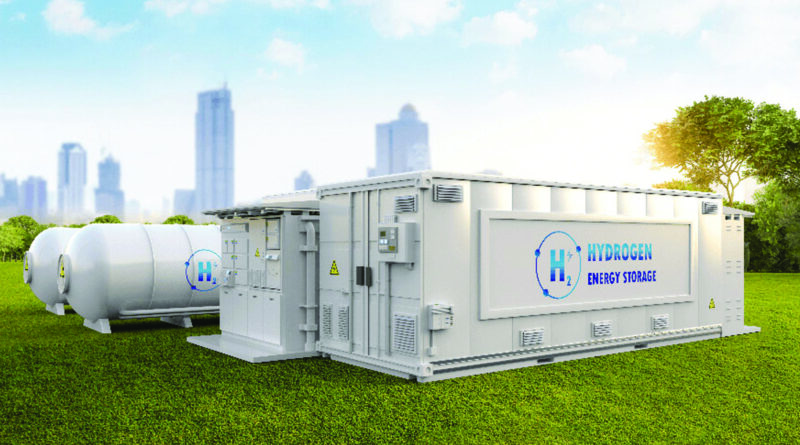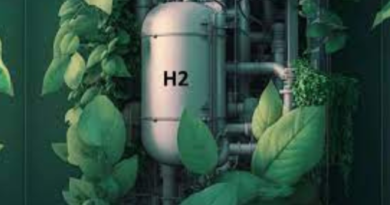Green Hydrogen-An Elixir for World’s Energy Needs
Abstract of Article
- Solar, wind, hydro and nuclear power have been known as alternative sources ofenergy since a long time. Hydrogen is relatively a new entrant on the block.
- There are various reasons as to why hydrogen, in particular, green hydrogen is beingviewed as a very strong contender to replace fossil fuels to fulfil our energy needs
- Hydrogen has twice the gravimetric energy density (i.e. energy available per unitmass of a substance), as compared to fossil fuels.
- There are certain use cases where it is not feasible to use other common renewableenergy sources. For ex- green hydrogen can be used as a fuel in very large vehicleswhere it is not possible to deploy huge battery packs in the vehicle
- According to International Atomic Energy Agency, green hydrogen currentlyaccounts for only 1 percent of the global hydrogen supply
- But in view of the thrust the governments across the world are giving to adoption ofgreen hydrogen, it can safely be said that green hydrogen can fulfill a substantial partof our energy needs in the near future
In the year 2022, when Union Roads & Transport Minister Sh. NitinGadkari drove a hydrogen fuel cell powered car to the Parliament, it attracted a lot of media frenzy. Generally, solar, wind, hydro and nuclear energy are the renewable sources of energy which are mostly talked about at various forums/in the media in our country. Suddenly, with this gesture by the Union Minister, hydrogen (as an alternative fuel) became the talk of the town.
Solar, wind, hydro and nuclear power have been known as alternative sources of energy since a long time. Hydrogen is relatively a new entrant on the block. As of now, the top 10 green hydrogen producing countries in the world are as shown below in the chart:
Top 10 Countries by Green Hydrogen Production (Cumulative Capacity 2023-2030)
But, what is it about hydrogen which makes it an attractive proposition to replace fossil fuels in the future.
There are various reasons as to why hydrogen, in particular, green hydrogen is being viewed as a very strong contender to replace fossil fuels to fulfil our energy needs.
The first reason is the vast energy generating potential of hydrogen. Hydrogen has twice the gravimetric energy density (i.e. energy available per unit mass of a substance), as compared to fossil fuels.As per the US Department of Energy Efficiency & Renewable Energy, the energy stored in 1 kg of hydrogen is approximately equal to that stored in about 3.78 litres of petrol.
Secondly, there are certain use cases where it is not feasible to use other commonrenewable energy sources. If we talk of transport sector, in electric vehicles, electricity needs to be stored in battery packs which are then used to power vehicles. There are certain modes of transport which require huge amounts of energy to power them and in these cases, it may be practically not possible to deploy huge battery packs. In such cases, hydrogen can be used as a fuel instead of battery packs. For example- Aviation Turbine Fuel (ATF) which is used in aircrafts, can be replaced with hydrogen.Hydrogen can be used as a fuel in very large vehicles also where it is not possible to deploy huge battery packs in the vehicle. Hydrogen, when compressed adequately, occupies very less volume and can be easily stored in fuel tanks of vehicles.
In industriesalso, hydrogen can replace fossil fuels. One such example is steel industry which consumes huge amounts of coking coal for steel making and this can be replaced with hydrogen.Infact, a major portion of coking coal required for steel making is imported by us because of its limited availability in the country.
Crude oil refining, fertilizer manufacturing etc. are some other industries which consume huge quantities of fossil fuels. Green hydrogen, if used in these cases, can help in reducing usage of fossil fuels to a great extent
Despite the fact that hydrogen is the most abundant element on our planet, it is rarely found in gaseous form. It is found in combination with other elements (like oxygen, with which it forms water i.e. H2O). Hence, it needs to be separated from these elements. As a result, there are different variants of hydrogen, depending upon the raw material/process used for the production of hydrogen. Some of the main variants of hydrogen are as follows:
Grey Hydrogen-Grey hydrogen is the most common form of hydrogen being used as a fuel today and is produced from natural gas/methane (which contains carbon).Steam is used for the production of grey hydrogen by a process called ‘Steam Reforming’ and in this process, carbon(pollutant) is released. For making every kilogram of hydrogen from natural gas, 11 kilograms of carbon dioxide is released.
However, if we talk in relative terms, the process of making grey hydrogen generates just a smaller amount of emissions if compared to the processes of generating black or brown hydrogen.
Blue Hydrogen-If, by using technology, the carbon that has been released during the making of grey hydrogen,is captured back, then the hydrogen so produced is called as blue hydrogen, instead of being called grey hydrogen. The process of capturing carbon and storing it underground is called industrial Carbon Capture & Storage(CCS). Hence,Blue hydrogen can be called as carbon neutral because the emissions are not released in the environment.
Black/Brown Hydrogen-Black hydrogen is produced from bituminous coal while brown hydrogen is produced from lignite variety of coal. In these two variants, CO2 and carbon monoxide are generated during the production process and both these gases are not recaptured. Hence, these forms of hydrogen can be called very polluting in nature
Green Hydrogen– This is the variant of hydrogen which is being looked upon by the world today,to reduce our dependence on fossil fuels and help us in transitioning from dirty fuels to clean energy.
Green hydrogen is produced from water (H2O) using renewable sources of energy. Purified water is fed into electrochemical devices called ‘water electrolyzers’, in which water is split into hydrogen and oxygen by passage of electric current.The water electrolyzer consists of two metal rods called electrodes, immersed into water and separated by amembrane. Hydrogen is produced by chemical reaction at one of the rods and oxygen at the another rod.The system also consists of equipment for cooling/processing of hydrogen produced (e.g. removing remaining traces of oxygen and drying of hydrogen), purification of incoming water as also compression and storage of final hydrogen.
The final hydrogen can be transported to different locations as per requirement.
The hydrogen fuel produced above can be converted into energy by means of a ‘fuel cell’. Basically, a hydrogen fuel cell works in the reverse principle as compared to a water electrolyzer. Hydrogen fuel and oxygen (from the air)undergo chemical reaction inside the cell to produce energy and water (in the form of steam) is released as residue.
About two-third of our earth is covered with water (raw material for green hydrogen).Also, renewable energy sources like solar, wind etc. are perpetual sources of energy. So, we can very well imagine the potential of green hydrogen to fulfill the world’s energy needs. Infact, if technology is developed that can produce green hydrogen in an economically viable way, it would not be an exaggeration to say that green hydrogen can prove to be an’elixir’for fulfilling world’s energy needs.
Our country has a long coastline of around 7,500 km which gives access to sea water. Ample sunlight and wind are also available in the country. Also, our country’s many industrial give producers of green hydrogen a captive market, while proximity to major global markets and our large ports give our country an advantage in the export markets.
Green hydrogen scores above even lithium ion batteries, currently being used in electric vehicles, in many ways. Firstly, lithium is a scarce element.
Secondly, a lithium mine takes many years of development before it starts commercial production.
Thirdly, as of now, only 3 countries i.e. Australia, Chile and China provide about 90 percent of global lithium supply, posing huge concentration risk in the global supply chain of lithium.
Also, lithium mining from hard rock mines involves usage of large amount of fossil fuels as well as water.It causes a lot of environmental damage to the area around the mines.
Safe disposal of lithium ion batteries is another area of concern plaguing their usage
Lithium ion batteries take considerable amount of time for their charging also whereas in case of green hydrogen, it can be filled in fuel tanks of vehicles within minutes, just like petrol and diesel.
Nickel, another component of lithium ion batteries, is also plagued by short supply.
Despite the huge potential held by green hydrogen to solve our energy needs, its production and usage has not gained much traction till now. This is because of certain factors.
One of the major roadblocks in the adoption of green hydrogen has been its high cost of production, with the currently available technology. As per a report in Forbes India, the current cost of production of green hydrogen in the country is around $3.6-$5.8 per kg. Production of green hydrogen is very costly in comparison to production of grey hydrogen which is the most widely used form of hydrogen as a fuel, as of now.
Issues relating to the storage, compression and transportation of the gas also act as stumbling blocks in promoting green hydrogen. Currently, in our country,there is dearth of essential infrastructure such as adequate pipelines and storage facilities to transport and store green hydrogen. As is the case with every new technology, the entire market and ecosystem associated with green hydrogen will have to be developed.
In view of the above difficulties, various countries across the world have taken upon themselves to push adoption of green hydrogenFor example, the US Govt. has highly subsidized production of green hydrogen under the Inflation Reduction Actand this has given some fillip to its use by the general public.
In our country also, the government is taking various initiatives to promote usage of Green Hydrogen.National Green Hydrogen Mission (NGHM) was approved on January 4, 2023 and was allocated an amount of Rs 19744 crores. Out of this amount, Rs 17490 crores has been earmarked for incentives. Under the mission, the Govt. has set a target of production of a minimum of 5MMT of green hydrogen by the year 2030. The production of this much of green hydrogen will require 125 GW of renewable energy as also 60-100 GW of electrolyzer capacity.If the target is met, it can lead to reduction of 50 MMT of CO2 emissions every year.
As per a news published in Moneycontrol, the Govt. is also working on making usage of green hydrogen mandatory for some sectors like oil refineries and fertilizers which are heavy users of fossil fuels
The private sector is also participating in a big way to realize the country’s green hydrogen ambitions.
As per a report published in Forbes India, Reliance Industries has forayed into areas like manufacture of solar panels, batteries as well as setting up solar farms to produce green hydrogen. The group has entered into partnership with a Danish company‘Stiesdal’ to manufacture electrolysers at the group’s factory in Jamnagar, Gujarat. These electrolysers will use electricity from Reliance’s own solar farms, which are also being built in Jamnagar, to produce green hydrogen. Reliance is aiming to produce green hydrogen for $1 per kg
The above report mentions that the Adani group has also announced that it will invest around$50 billion over the next 10 years to produce green hydrogen and create related ecosystem for the same. The group is targetingdevelopment of green hydrogen capacity of 10 lakh tonnes per year, before 2030, as part of the first phase.
Another big industrial house, JSW Energy, is setting up a 3,800-tonne hydrogen plant in Karnataka, with 25 megawatts of round-the-clock renewable power. The plant will be operational before March 2025. The group aims to use green hydrogen to de-carbonise its steel making process and produce green steel, the demand for which is strong in domestic and international markets.
‘Green Finance’ is a concept that is increasingly being talked about these days when it comes to fulfilment of credit requirements of various projects. The Reserve Bank of India considers that finance as ‘Green Finance’ which is meant for projects that are environmentally sustainable. In other words, if a project gives due weightage/consideration to climate change concerns, then credit extended to such a project is classified as ‘Green Finance’.
As per a RBI report titled Survey on Climate Risk & Sustainable Finance, published in July 2022, majority of the banks in the country will substantially reduce their credit exposure to high carbon emitting businesses in the coming years. Banks are raising new capital called ‘Green Capital’ meant solely for financing of environmentally sustainable projects in the country
Our country has set ambitious targets to ramp up green hydrogen production in the country, under the National Green Hydrogen Mission. Since, setting up green hydrogen projects requires huge capex, banks and NBFCs have a critical role to play in achieving the country’s green hydrogen production targets. Apart from expenditure incurred in setting up of the new projects, financing is also required for extensive research work, since the production cost of green hydrogen is currently very high and it needs to be reduced substantially to enable mass acceptance of usage of green hydrogen.
As per a report in The Economic Times dated Dec 18, 2023; State Bank of India along with some other banks are working with the government to draw up a uniform financing framework for green hydrogen projects which will include aspects like credit appraisal, risk assessment etc. This will streamline the process of sanctioning of green hydrogen projects. For this purpose, a committee comprising of representatives from banking sector, industry etc. has been set up to give recommendations to the Govt. The initiative is being led by the Ministry of New & Renewable Energy, Govt. of India
The Govt. of India has also recommended to the RBI to include Green Hydrogen financing under the priority sector lending. If done, it will open up another avenue for the banks to fulfill their priority sector lending targets, besides boosting the credit flow to green hydrogen projects
To conclude, it can be said that the transition to green hydrogen cannot happen overnight. The technology for green hydrogen production is in the initial stages right now and it will need sustained efforts for a considerable amount of time before production of green hydrogen can be done in an economically viable manner, without any monetary support from the Govt. We can take heart from the fact that solar and wind power were also prohibitively expensive to produce during their initial stages of development. But with the passage of time, their cost of production has come down substantially.For example, as per a report by International Renewable Energy Agency (IRENA), the weighted average Levellised Cost of Electricity (LCOE) in case of onshore wind power projects in our country has fallen from $0.2374 per KWh in 1990 to $0.0299 per KWh in 2021, implying a 87.40% reduction in cost. Since, cost of electricity generated from renewable sources is one of the major cost components in green hydrogen production, it will have a positive impact on the overall green hydrogen production cost also. As per a report by GEP, a global leader in supply chain transformation consultancy, the cost of electrolyzers has already come down by around 60% since 2010. Hence, it can be said that right steps are being taken by various stakeholders to make green hydrogen a viable alternative source of energy
According to International Atomic Energy Agency, green hydrogen currently accounts for only 1 percent of the global hydrogen supply. But in view of factors like urgent need to tackle adverse effects of climate change, extensive push by governments across the world to green hydrogen, global investors opting for sustainable businesses in their portfolios etc.; it can safely be said that green hydrogen will fulfill a substantial part of our energy needs in the near future. The only thing required will be to maintain the momentum built now to develop an optimum green hydrogen ecosystem.



